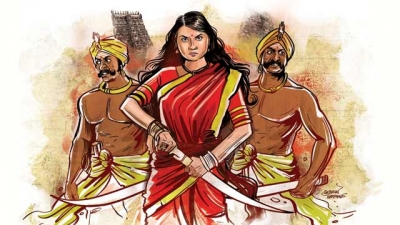
Veeramangai Velu Nachiyar
Velu Nachiyar was born in 1730, into the Ramnad royal family in Tamil Nadu. Velu was given an exceptional education- something unusual for that time. She spoke ten languages, including English, French, Urdu, and Persian. She learned many martial arts including sword fighting and archery; she was an expert at Tamil techniques such as the Silambam (fighting with bamboo sticks), and the valari ( a boomerang-like weapon). Velu was married to Muthu Vaduganatha Periyavudaya Thevar, the prince of Sivaganga. In a rare sort of legend, it is told that when she was roaming in the beautiful forests of Courtallam as a bride, a tiger attacked her husband. Instead of shying away, the story goes, Velu caught hold of the tiger’s tail, jumped on its back and strangled it with her bare hands!
The British invaded Sivaganga in 1772 to collect ‘unpaid dues’ on behalf of the Nawab of Arcot. The king, Velu’s husband Muthu, was caught unaware at a temple and killed. Sivaganga was thereafter occupied by the Nawab of Arcot.
Escape to Mysore
Swearing dire revenge, Velu escaped to the neighbouring kingdom of Mysore, ruled by Haider Ali. A meeting was arranged, but when Haider Ali entered the hall, he saw only men. When he asked for Velu, she revealed herself by pulling off her turban, and addressed him in excellent Urdu. Impressed, he made her allowance of 400 gold coins, and asked her to live on in his fort in Dindigul until it was the right time to retake Sivaganga.
Preparation for Revey
Velu prepared for her revenge diligently for the next eight years, creating spy networks and support groups in Sivaganga.
She also, most unusually , trained an army of women and her Dalavai, or commander, was Kuyili, a Dalit.
Women Warriors March on
In 1780, Haider invaded the Carnatic, crossing over the Eastern Ghats and descending on the Nawab of Arcot’s territories on the east coast with 80,000 soldiers, engaging the British on many fronts.
Velu’s moment had finally come. With a small force lent to her and her women’s troops. Velu started her inexorable march to Sivaganga, the locals pouring out to join her. Along the way, she fought both the Nawab’s and British troops, but overcame them. They reached the outskirts of Sivaganga on the night before Vijayadashami.
Of Grit and Courage
Sivaganga, however, was well fortified and not easy to enter. Velu now came up with a plan. As it was Vijayadashami, Velu and her woman warriors mingled with the throngs of local women going to the temple of Rajarajeshwari, which was conveniently next to the palace . As soon as they got into the palace complex, they tried to capture it. Popular depictions of this scene always show the women pulling out their hidden swords, and attacking the soldiers shouting ‘Vetrivel, Veeravel’, the ancient Tamil battle cry. Vel is the divine spear used by the god Murugan – the war cry translates to: ‘Victorious Vel, Courageous Vel’. Their weapons, however, were no match for the British guns. Velu quickly realized that the room that stored British ammunition had to be destroyed. Kuyili, her brave commander, fought her way to the room. As she neared the entrance, she doused herself with oil from the burning lamps, set herself on fire, and hurled herself into the room, blowing up all the ammunition. Kuyili is now considered the first ‘human bomb’. She is also lauded as a Dalit icon. The women now took control, rang the temple bells to signal their forces outside, and Sivaganga was liberated.
Regions kingdom
Velu ruled for many years on behalf of her minor daughter Vellachi. When Velu was sixty, she became unwell, apparently with a heart problem. She handed over the kingdom to Vellachi, and went off to France for medical treatment in 1791. This was France in the throes of the revolution, one wonders what her experience might have been. She is supposed to have returned in 1793 and lived a retired life until her death in 2796.
In memory of Udaiyal
Special temple for people complaining against the Government
When Velu had fled to Mysore, she was closely followed by the British. Enroute, they questioned Udaiyal, a girl grazing her cattle, and when she refused to divulge the queen’s whereabouts they tortured her to death. Velu named her army of women Udaiyal padai in memory of this brave girl who had given up her life.
After regaining her kingdom, one of the first things Velu did was to build a temple enshrining Udaiyal, the shepherd girl as Kali; she then donated her thaali (mangalsutra) as the first offering in the temple. Even today, one can visit the temple in Ariyakuruchi village. The goddess is particularly popular with pilgrims suffering injustice at the hands of the government, and those seeking revenge: supplicants pray to Udaiyal Kali fir redress, and cut a coin in two with a chisel and mallet, perhaps symbolizing an attack on the king whose head was normally depicted on the coin.
Picture Credit : Google




